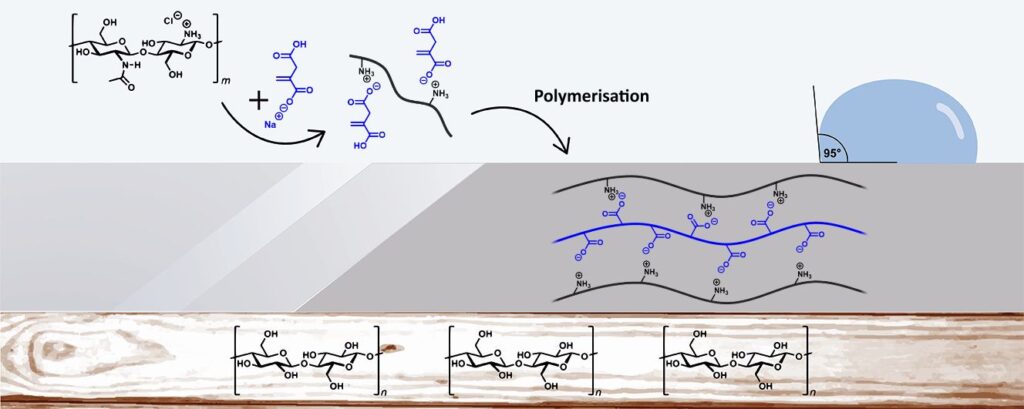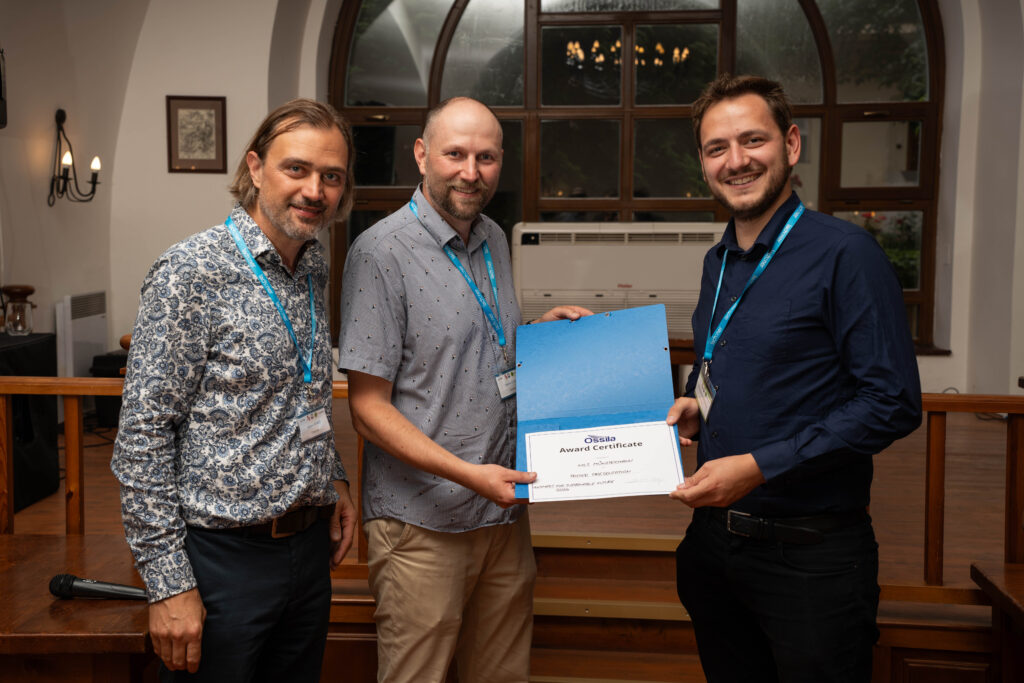Kategorie: ‘Chitosan’
Joint publication:Plant protection from insect larvae

The black soldier fly (Hermetia illucens) not only offers a sustainable source of protein, but also the potential to extract chitosan – a versatile biopolymer – from the larval skins. A joint study with the research group led by Dr. Sabine Gruber from the University of Innsbruck and the FH Campus Vienna shows how biological waste from BSF production can be processed into bioactive chitosan using environmentally friendly enzymatic processes. This chitosan has strong antifungal properties and improves the germination and disease resistance of plants such as sugar beet. It therefore offers an environmentally friendly alternative to chemical fungicides and chitosan, which is obtained from crescent shells. This innovation underlines the potential of the insect industry to make good use of waste and create sustainable solutions for agriculture and industry.
C. Escobar Rodríguez, V. Zaremska, T. Klammsteiner, I. Kampatsikas, N. Münstermann, O. Weichold, S. Gruber
Chitosan obtained from black soldier fly larval cuticles expands the value chain and is effective as a biocontrol agent to combat plant pathogens
Carbohydrate Polym. 2025, 349, Part B, 123023 https://doi.org/10.1016/j.carbpol.2024.123023
New publication: Fire-retardant wood coating

Wood is currently experiencing a renaissance in the construction and furniture industry. With its natural charm, versatility and environmental friendliness, wood is a popular building material. However, this natural material is susceptible to external influences such as moisture, UV radiation, stains and, above all, fire. Fire in particular poses a major risk in the construction industry due to the easy flammability of wood. Once ignited, untreated wood often burns down completely without any external heat supply. N. Münstermann and O. Weichold have now developed an innovative, sustainable wood coating based on polymerized chitosanitaconate. The basis of the coating, chitosan, is a residual product from the food industry and itaconic acid can be obtained biotechnologically. The coating is therefore made entirely from bio-based materials and not only offers protection against moisture, UV radiation and stains, but is also non-flammable. When applied to wood, it delays ignition and significantly inhibits the spread of flames. Just one coat reduces the burning rate by a third. Two coats on spruce wood are enough to make the material self-extinguishing. Three layers are required for hardwoods such as beech. This bio-based approach combines resource conservation with high effectiveness and shows that environmental protection and safety requirements can go hand in hand.
N. Münstermann, O. Weichold
A fire-retardant coating for wood made from chitosan itaconate
Progress in Organic Coatings 2024, 197, 108793 https://doi.org/10.1016/j.porgcoat.2024.108793
6th Junior EPNOE
At the 6th European Polysaccharide Network of Excellence (EPNOE) Junior Scientist Meeting 2024, September 4-6, 2024 in Vienna, Austria, we were represented with two contributions:
Nils Münstermann
High-Strength Chitosan-bonded Fibreboards in Sustainable Construction (presentation)
Paul Marten
Development of a Chitosan-Based Adhesive for Wood-Acrylic Glass Laminates (short presentation and poster)
New publication: Wood coating made from biogenic residues

Wood has been a central building material for mankind for thousands of years and is characterised by its bioavailability, sustainability and versatility. Nevertheless, the chemical structure of wood poses a number of challenges. It is susceptible to biological degradation processes, for example by fungi, bacteria or insects, and shows signs of graying due to lignin degradation when exposed to UV radiation. To prevent this, N. Münstermann and O. Weichold have developed an environmentally friendly coating based on chitosan, a biopolymer obtained from food waste.
The newly developed chitosanitaconate coating is transparent, emphasizes the wood grain and gives the wood hydrophobic properties with contact angles of over 90°. It effectively protects the wood from moisture, prevents graying caused by UV radiation and reduces staining caused by coffee or red wine, for example. Thanks to its strong adhesion and adaptability, the coating is highly versatile. By adding pigments, the coating can be adapted to the aesthetic requirements of modern interior design. Chitosanitaconate combines wood protection, modern aesthetics and sustainability – a versatile solution for environmentally friendly construction.
N. Münstermann, O. Weichold
Chitosan itaconate based water- and stain-repellent coatings for wood
Progress in Organic Coatings 2024, 194, 108630 https://doi.org/10.1016/j.porgcoat.2024.108630
Presentation
Nils Münstermann gave a presentation entitled ‘Chitosan as an environmentally friendly binder for high-strength fibreboards’ at the 2024 doctoral seminar of the GDCh Construction Chemistry Division in Aachen, Germany.
Presentation
Paul Marten gave a presentation entitled ‘Development of a chitosan-based adhesive for wood-acrylic glass bonding’ at the 2024 doctoral seminar of the GDCh Construction Chemistry Division in Aachen, Germany.
Nils Münstermann earns an Award

Nils Münstermann receives the poster prize at the Polymers for Sustainable Future 2024 conference in Prague for his contribution ‘Chitosan-Based Coatings for the Water-Proofing of Wood’.
WTA-Days 2024
We were represented with a total of four lectures at the WTA Days 2024, 14-16 March 2024 in Brno, Czech Republic.
Prof Weichold presented a lecture entitled ‘Alkaline hydrogels as multifunctional repair materials’. From the field of bio-based construction materials, Fabian Weitenhagen gave a presentation on ‘Renewable Polyester Resin Systems for Sustainable Construction Materials’, Paul Marten gave a presentation on ‘Chitosan as a Key Component in the Production of Sustainable Acrylic Glass-Wood Laminates’ and Nils Münstermann gave a presentation on ‘Chitosan as an Eco-Friendly Binder for High-Strength Fibreboards in Sustainable Construction’.
New PhD Student
Since July, we have welcomed Paul Marten to the bio-based building materials department. As part of his dissertation, he is working on the derivatisation of chitosan and its application, including as an additive for PLA and as an adhesive or primer for wood/PMMA composite systems or wood laminates, for example. The aim of his research is to develop bio-based, sustainable and biodegradable systems with outstanding physical properties, while avoiding petrochemical substances as far as possible. We wish him every success in his research and welcome him to the working group.
Completed Master Thesis
Congratulations to Paul Marten on successfully completing his Master’s thesis entitled ‘Development of chitosan lactate-based additives for polylactide (PLA)’ in the Chemistry degree programme.



